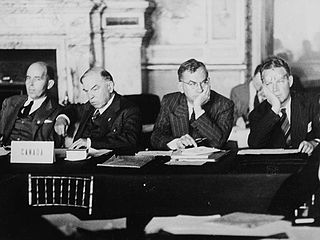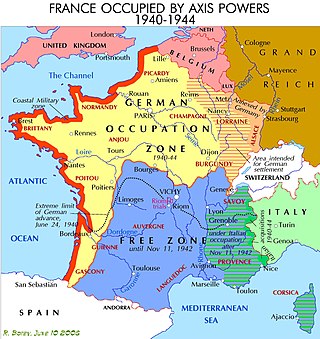Related Research Articles

The Axis powers, originally called the Rome–Berlin Axis and also Rome–Berlin–Tokyo Axis, was a military coalition that initiated World War II and fought against the Allies. Its principal members were Nazi Germany, Fascist Italy and the Empire of Japan. The Axis were united in their far-right positions and general opposition to the Allies, but otherwise lacked comparable coordination and ideological cohesion.

The Paris Peace Treaties were signed on 10 February 1947 following the end of World War II in 1945. The Paris Peace Conference lasted from 29 July until 15 October 1946. The victorious wartime Allied powers negotiated the details of peace treaties with those former Axis allies, namely Italy, Romania, Hungary, Bulgaria, and Finland, which had switched sides and declared war on Germany during the war. They were allowed to fully resume their responsibilities as sovereign states in international affairs and to qualify for membership in the United Nations. Nevertheless, the Paris Peace Treaties avoided taking into consideration the consequences of the Molotov–Ribbentrop Pact, officially known as the Treaty of Non-Aggression between Germany and the Union of Soviet Socialist Republics, whose secret clauses included the division of Poland between Nazi Germany and the Soviet Union, the occupation of the Baltic States, and the annexation of parts of Finland and Romania. The Molotov–Ribbentrop Pact changed the borders agreed after the Paris Peace Conference (1919–1920), and was signed on August 23, 1939. One week later, World War II started with Nazi Germany's invasion of Poland, followed three weeks later by the Soviet invasion of Poland, which was completely erased from the map. In the following years, Nazi Germany and the Soviet Union changed the borders established by the peace treaties at the end of World War I.
The Kingdom of Romania, under the rule of King Carol II, was initially a neutral country in World War II. However, Fascist political forces, especially the Iron Guard, rose in popularity and power, urging an alliance with Nazi Germany and its allies. As the military fortunes of Romania's two main guarantors of territorial integrity—France and Britain—crumbled in the Fall of France, the government of Romania turned to Germany in hopes of a similar guarantee, unaware that Germany, in the supplementary protocol to the 1939 Molotov–Ribbentrop Pact, had already granted its blessing to Soviet claims on Romanian territory.
Following the termination of hostilities in World War II, the Allies were in control of the defeated Axis countries. Anticipating the defeat of Germany, Italy and Japan, they had already set up the European Advisory Commission and a proposed Far Eastern Advisory Commission to make recommendations for the post-war period. Accordingly, they managed their control of the defeated countries through Allied Commissions, often referred to as Allied Control Commissions (ACC), consisting of representatives of the major Allies.

The Armistice of 22 June 1940, sometimes referred to as the Second Armistice at Compiègne, was an agreement signed at 18:36 on 22 June 1940 near Compiègne, France by officials of Nazi Germany and the French Third Republic. It became effective at midnight on 25 June.

Case Anton was the military occupation of Vichy France carried out by Germany and Italy in November 1942. It marked the end of the Vichy regime as a nominally-independent state and the disbanding of its army, but it continued its existence as a puppet government in Occupied France. One of the last actions of the Vichy armed forces before their dissolution was the scuttling of the French fleet in Toulon to prevent it from falling into Axis hands.

The Allies, formally referred to as the United Nations from 1942, were an international military coalition formed during World War II (1939–1945) to oppose the Axis powers. Its principal members by the end of 1941 were the "Big Four" – the United Kingdom, United States, Soviet Union, and China.

During World War II, the Spanish State under Francisco Franco espoused neutrality as its official wartime policy. This neutrality wavered at times, and "strict neutrality" gave way to "non-belligerence" after the Fall of France in June 1940. Franco wrote to Adolf Hitler offering to join the war on 19 June 1940 in exchange for help building Spain's colonial empire. Later in the same year Franco met with Hitler in Hendaye to discuss Spain's possible accession to the Axis Powers. The meeting went nowhere, but Franco did help the Axis—whose members Italy and Germany had supported him during the Spanish Civil War (1936–1939)—in various ways.

The Military Administration in France was an interim occupation authority established by Nazi Germany during World War II to administer the occupied zone in areas of northern and western France. This so-called zone occupée was established in June 1940, and renamed zone nord in November 1942, when the previously unoccupied zone in the south known as zone libre was also occupied and renamed zone sud.

The scuttling of the French fleet at Toulon was orchestrated by Vichy France on 27 November 1942 to prevent Nazi German forces from seizing it. After the Allied invasion of North Africa, the Germans invaded the territory administered by Vichy under the Armistice of 1940. The Vichy Secretary of the Navy, Admiral François Darlan, defected to the Allies, who were gaining increasing support from servicemen and civilians. His replacement, Admiral Gabriel Auphan, guessed correctly that the Germans intended to seize the large fleet at Toulon, and ordered it scuttled.
The French State, popularly known as Vichy France, as led by Marshal Philippe Pétain after the Fall of France in 1940 before Nazi Germany, was quickly recognized by the Allies, as well as by the Soviet Union, until 30 June 1941 and Operation Barbarossa. However, France broke with the United Kingdom after the destruction of the French Fleet at Mers-el-Kebir. Canada maintained diplomatic relations until the occupation of Southern France by Germany and Italy in November 1942.

The percentages agreement was a secret informal agreement between British Prime Minister Winston Churchill and Soviet leader Joseph Stalin during the Fourth Moscow Conference in October 1944. It gave the percentage division of control over Eastern European countries, dividing them into spheres of influence. It is also known as the naughty document, a nickname coined by Churchill himself due to his concerns regarding American reaction to any deal with such strong imperialist undertones, although in reality U.S. President Franklin Roosevelt was consulted tentatively and conceded to the agreement. The content of the agreement was first made public by Churchill in 1953 in the final volume of his memoir. The US ambassador Averell Harriman, who was supposed to represent Roosevelt in these meetings, was excluded from this discussion.

Vichy France, officially the French State, was the French rump state headed by Marshal Philippe Pétain during World War II. It was named after its seat of government, the city of Vichy. Officially independent, but with half of its territory occupied under the harsh terms of the 1940 armistice with Nazi Germany, it adopted a policy of collaboration. Though Paris was nominally its capital, the government established itself in the resort town of Vichy in the unoccupied "free zone", where it remained responsible for the civil administration of France as well as its colonies. The occupation of France by Nazi Germany at first affected only the northern and western portions of the country, but in November 1942 the Germans and Italians occupied the remainder of Metropolitan France, ending any pretence of independence by the Vichy government.

The zone libre was a partition of the French metropolitan territory during World War II, established at the Second Armistice at Compiègne on 22 June 1940. It lay to the south of the demarcation line and was administered by the French government of Philippe Pétain based in Vichy, in a relatively unrestricted fashion. To the north lay the zone occupée, in which the powers of Vichy France were severely limited.

The Franco-Italian Armistice, or Armistice of Villa Incisa, signed on 24 June 1940, in effect from 25 June, ended the brief Italian invasion of France during the Second World War.

Hessische Staatskanzlei is located in the Mitte borough of Wiesbaden, Hesse, Germany, opposite Kochbrunnenplatz. The former Grand Hotel Rose, representative of the Wilhelminian period in which it was constructed, is the seat of the government of the State of Hesse. The cabinet meetings of the state government also take place there. The acting head of the Hessian State Chancellery has been Axel Wintermeyer since August 31, 2010.

The French demarcation line was the boundary line marking the division of Metropolitan France into the territory occupied and administered by the German Army in the northern and western part of France and the Zone libre in the south during World War II. It was created by the Armistice of 22 June 1940 after the fall of France in May 1940.
During World War II, the Commissione Italiana d'Armistizio con la Francia or CIAF was a temporary civil and military body charged with implementing the Franco-Italian armistice of 24 June 1940 and harmonising it with the Franco-German armistice of 22 June. It had broad authority over the military, economic, diplomatic and financial relations between France and Italy until the Italo-German occupation of France on 11 November 1942. Thereafter its powers were gradually transferred to the Fourth Army, which was under the command of General Mario Vercellino and in occupation of southern France. The headquarters of the CIAF was in Turin and it was subordinate to the Comando Supremo. It liaised with the German Armistice Commission in Wiesbaden.

The Government of Vichy France was the collaborationist ruling regime or government in Nazi-occupied France during the Second World War. Of contested legitimacy, it was headquartered in the town of Vichy in occupied France, but it initially took shape in Paris under Marshal Philippe Pétain as the successor to the French Third Republic in June 1940. The government remained in Vichy for four years, but fled to Germany in September 1944 after the Allied invasion of France. It operated as a government-in-exile until April 1945, when the Sigmaringen enclave was taken by Free French forces. Pétain was brought back to France, by then under control of the Provisional French Republic, and put on trial for treason.
References
- United States Department of State, Publication No. 6312, Documents on German Foreign Policy 1918-1945, Series D, IX, 671-676. Washington, DC: Government Printing Office, 1956.
- "Armistice & After". Time . 5 July 1940. Archived from the original on 20 March 2007. Retrieved 20 October 2009.